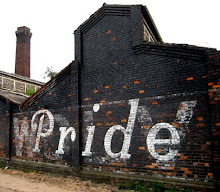 An initial investigation of Broad Street Basin and bridge, the intersection of rail, road and canal. Linkages and ways in.
An initial investigation of Broad Street Basin and bridge, the intersection of rail, road and canal. Linkages and ways in.The relationships between rail road and canal in this area brought me to a crucial point, the Broad Street Basin. There is curious mix here of traditional canal activities, the Canal nightclub in the Broad Street Depot and the railway bridge that cuts off the old route of Broad Street into the Wednesfield Road. The Canal, Rail and Ring Road serve as divisions to what is beyond. Perhaps this is due to the removal of the old bridge ( pictured) in the 1970's to the rather generic functional one there now, the same sort of languid bridge design that has prolifereated along our canal system. Perhaps that is why after we pass under this bridge and move toward the station and Horseley Fields, Cambridge Cyclist Campaign earmark it as 'worth avoiding'.
Of course small remaining details become illuminated through the imagination, although you have to work hard past other elements, rather than those elements working together harmoniously. Engaging with this landscape , it is difficult to percieve that sense of specific identity that emerges through, for example, walking along the brewery wall. What is undeniably certain is that this place marks the start of an area intimately connected with the canal and its industries and the lifestyles associated with that.
I'm going back to the story of Bill Lloyd carrying his first bottles of 'smackers' back from the brewery on his first day, along the canal on his bike, or Dennis Groves walking into town after a Saturday morning's work, or even activities such as the May Day parade in Cambridge Street. There was an environment that encourages this activity. Derek Wiggins told me of 'Courtyard Back' housing and walking past washing lines dripping with clothes; that the walk home was full of rich activities that augment the particular experience of this place and set firm memories . I wonder about the same enthusiasm and fondness guilding a conversation of the place today.
What is lacking now is that overt sense of activity and those interconnected detailed experiences of navigating through these passages to and from the Springfield area.
I am aware planned changes are beneficial , but there are further opportunities. The invisible wall created by the railway bridge , canal and ring road on the outskirts of the City Centre could be turned upside down, so that this area becomes synonymous with interconnecting movement and the 'darkness' of the Broad Street Basin turned to 'light'. The intended changes to routes and passageways for cyclists and pedestrians canbe informed to illuminate subtle clues to Wolverhampton's rich identity though the experience of travelling these paths.
The old bridge is now at the Black Country Museum. There may have been structural reasons for its removal, but this is exactly what the place is missing. A route over bridge gave us that insight into how to percieve the landscape, it embodied the sensibilities of Wolverhampton - as we saw it approaching, travelled over it, leaned on it, looked over into the canal on the way to the Union Inn, our activities became intertwined with the place and with the bridge itself. The materials it is made with, its form, colour and possibly the sound it may have made as we travelled over it, allowed us to step within the 'grain' of Wolverhampton and engage with it through recognising the industrial traditions and historical activities intimately tied to this minor place. It was one way in.
Of course we are not coming back from, or going to work from the Brewery, Culwell Foundry, the Steam or Corn Mill. However on those journeys to and from the city centre, to the Interchange, to Springfield and so on, we can go about out daily lives by choosing to enjoy and engage with the city and it rich, complex layers. We can choose to create new ways in. Those new routes can perform and function as the minor route over the bridge did, not simply as something that stops us falling in the water, or something that gets us from A to B in the quickest time possible. Painting and paving can involve so much more.
Within the fabric of these physical connections are other connections and bridges between how we use, how we percieve and how we place ourselves within the city. It is how we connect up those current hidden activities and desires of people in the area to the changing landscape and bring those attributes harmoniously to the surface.








+copy.jpg)

No comments:
Post a Comment